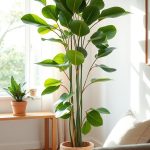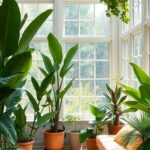Carnivorous plants make for fascinating and quirky additions to any terrarium, combining the beauty of nature with a touch of the extraordinary. From the iconic Venus flytrap to the elegant sundew, these unique plants thrive in vibrant mini ecosystems that are both fun to create and intriguing to maintain. Let’s explore some creative ideas to inspire your own carnivorous plant terrarium project!
Terrarium with Insect Friends
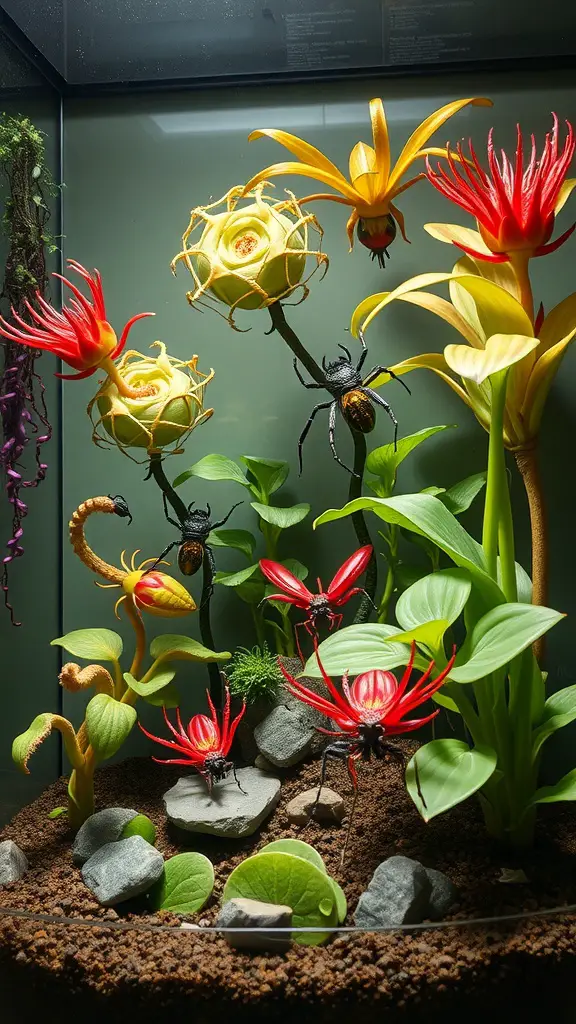
This terrarium showcases a vibrant mix of carnivorous plants and playful insect figures. The bright colors of the flowers really pop against the lush green leaves. You can see unique plants like the Venus flytrap and sundew, which are designed to attract and catch insects.
Adding insect figures gives this terrarium a fun twist. It creates a lively scene that sparks imagination. The spiders and other bugs look like they are part of the plant’s natural habitat, enhancing the overall theme.
Using a mix of textures, like smooth stones and rich soil, adds depth to the design. This setup not only looks great but also serves as a conversation starter. It’s perfect for anyone who loves nature and wants to bring a bit of the wild indoors.
Nepenthes Jungle Vibe
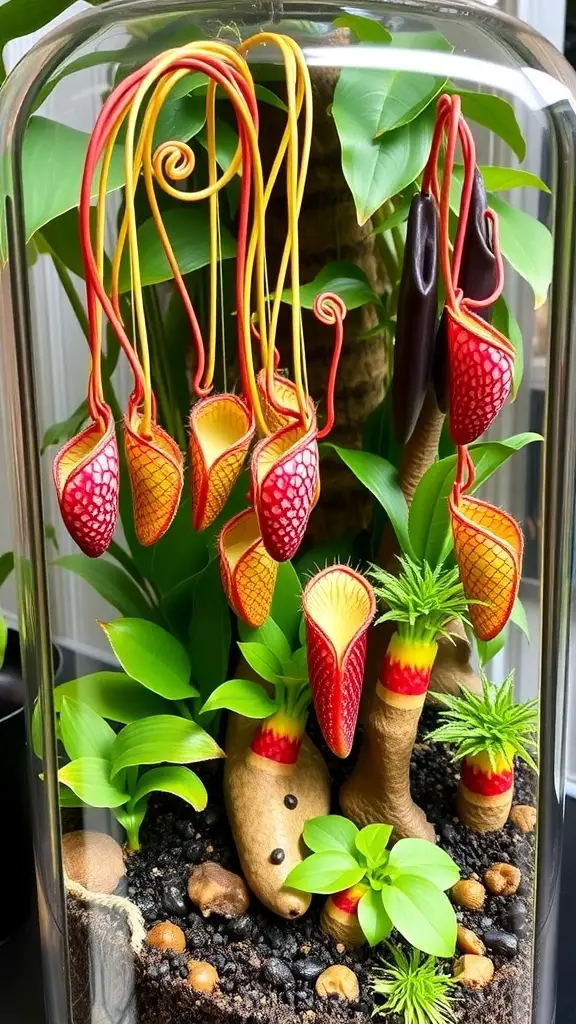
Nepenthes plants, often called pitcher plants, bring a unique jungle vibe to any terrarium. Their elongated, tubular pitchers hang gracefully, creating a striking visual effect. These plants thrive in humid environments, making them perfect for a tropical terrarium setup.
The image showcases a cluster of these fascinating pitchers, each ready to catch unsuspecting insects. The vibrant green leaves surrounding them add to the lush atmosphere, making it feel like you’ve stepped into a mini rainforest. Incorporating Nepenthes into your terrarium not only enhances its beauty but also adds an element of intrigue.
To create your own Nepenthes jungle vibe, consider using a glass container that allows for plenty of light. Fill it with a mix of sphagnum moss and orchid bark to provide the right drainage and moisture. Position the Nepenthes so their pitchers can hang freely, allowing them to thrive and attract their next meal!
Miniature Carnivore Ecosystem
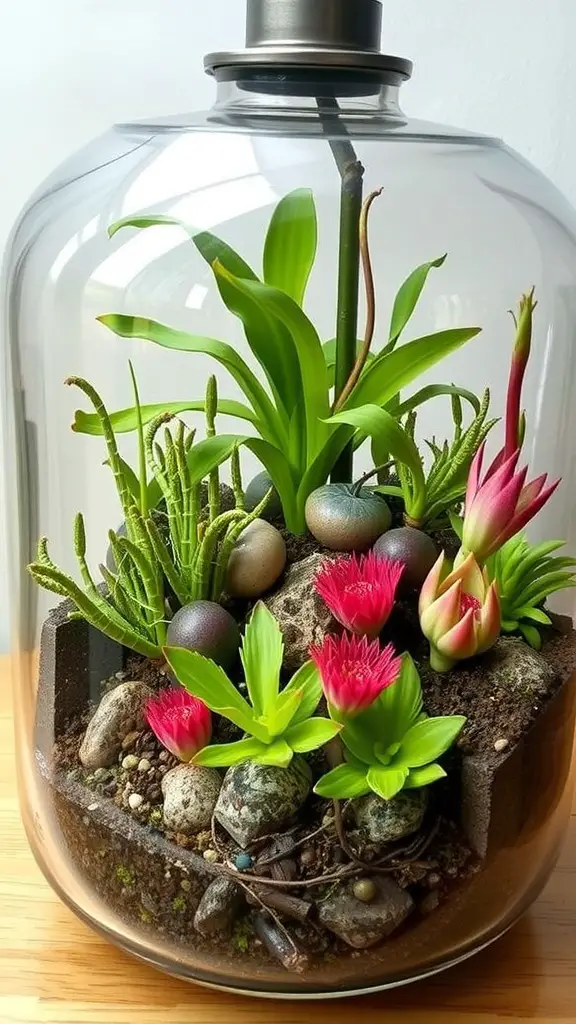
Creating a miniature carnivore ecosystem can be a fun and rewarding project. The image showcases a beautifully arranged terrarium filled with various carnivorous plants. You can see vibrant colors and textures that bring life to this tiny world.
The terrarium features a mix of plants, including striking red flowers and lush green foliage. These plants thrive in a carefully balanced environment, making them perfect for a small indoor garden. The rocks and decorative elements add a natural touch, enhancing the overall aesthetic.
Setting up your own miniature ecosystem is simple. Start with a glass container, add a layer of drainage stones, and then fill it with a suitable soil mix. Plant your carnivorous varieties, like Venus flytraps or sundews, and arrange the decorative stones. Remember to maintain humidity and light for optimal growth.
This miniature ecosystem not only looks great but also serves as a conversation starter. It’s a unique way to appreciate the beauty of carnivorous plants while learning about their fascinating habits.
Layered Plant Terrarium
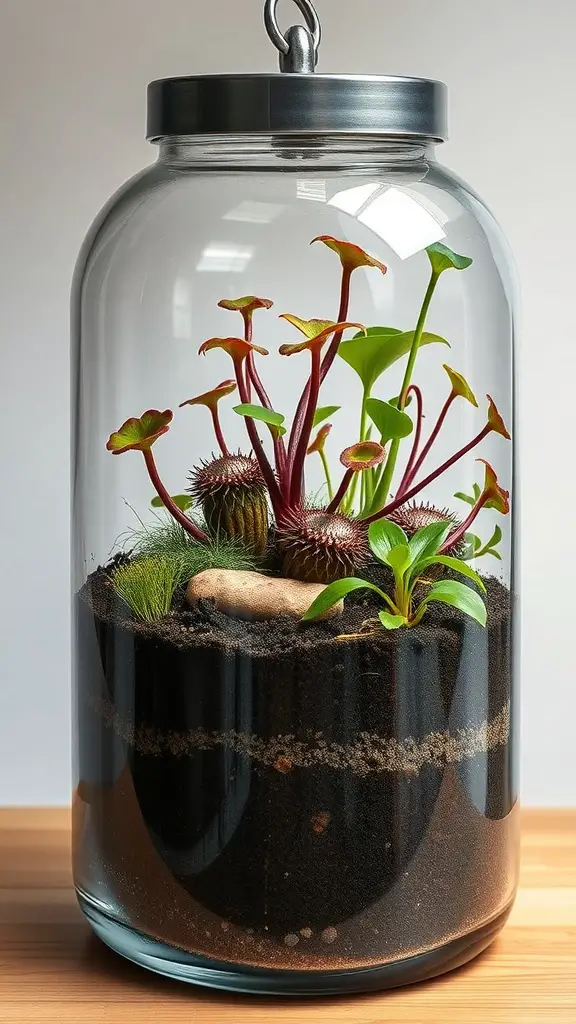
A layered plant terrarium is a stunning way to showcase carnivorous plants. This design creates visual interest and provides different environments for each plant type. In the image, you can see a beautiful arrangement of various carnivorous plants, each thriving in its own layer.
The terrarium features vibrant plants like pitcher plants and sundews, which are known for their unique shapes and colors. The layering technique allows for a mix of soil types, ensuring that each plant gets what it needs to grow. The dark soil contrasts nicely with the bright greens and reds of the plants, making them pop.
Using a glass container, like the one shown, not only protects the plants but also allows light to filter through, enhancing their colors. This setup is perfect for anyone looking to add a touch of nature to their home. Just remember to keep an eye on humidity and light levels, as carnivorous plants have specific needs.
Colorful Carnivorous Garden
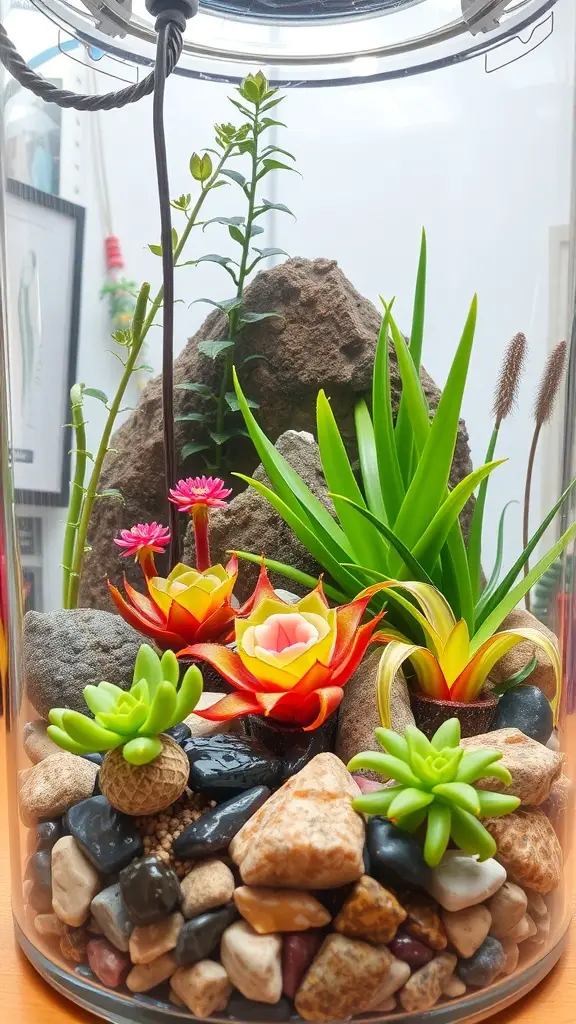
Creating a colorful carnivorous garden can be a fun and rewarding project. The image showcases a vibrant terrarium filled with various plants, rocks, and decorative elements. Each plant adds a unique touch, making the garden visually appealing.
The bright colors of the flowers contrast beautifully with the earthy tones of the rocks. This combination creates a lively atmosphere, perfect for any space. The arrangement of the plants is key; placing taller plants in the back and shorter ones in the front allows for a layered look.
Using different textures, like smooth stones and rough rocks, adds depth to the terrarium. The overall design invites curiosity and admiration. It’s a great way to bring a bit of nature indoors while showcasing the beauty of carnivorous plants.
Venus Flytrap Wonderland
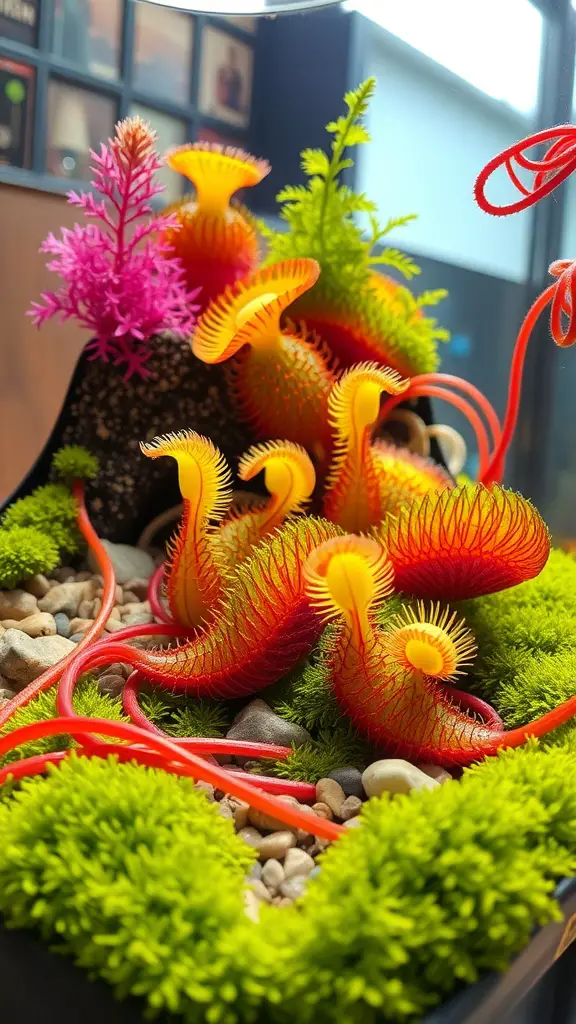
Imagine stepping into a vibrant world filled with unique plants that seem to come straight out of a fantasy book. The Venus Flytrap is a star here, showcasing its striking red and yellow colors. These plants are not just visually stunning; they are fascinating carnivores that catch insects with their snapping traps.
This terrarium features a playful arrangement of Venus Flytraps, surrounded by lush green moss and colorful accents. The combination of textures and colors creates a lively atmosphere, making it a perfect centerpiece for any room. The pebbles add a natural touch, enhancing the overall look.
Creating a Venus Flytrap terrarium is a fun project. Start with a suitable container, add a drainage layer, and fill it with a mix of peat moss and perlite. Place the Flytraps strategically to allow them to thrive. Remember to keep the environment humid and provide bright, indirect light. This way, your little carnivorous garden can flourish!
Dewy Sundew Display
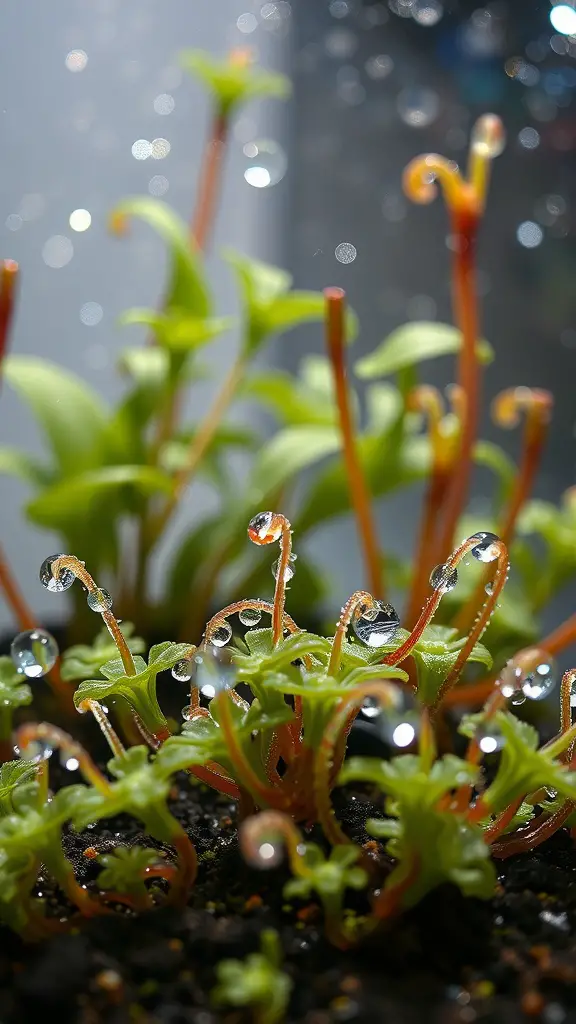
The dewy sundew is a captivating plant that adds a unique touch to any terrarium. Its delicate, sticky tentacles glisten with droplets of water, creating a stunning visual effect. These droplets not only look beautiful but also serve a purpose—they attract and trap insects, making the sundew a fascinating carnivorous plant.
In a terrarium setting, the sundew thrives in a humid environment. Placing it alongside other carnivorous plants can create a mini ecosystem that mimics its natural habitat. The contrast between the sundew’s vibrant green leaves and the sparkling water droplets makes for an eye-catching display.
To care for your dewy sundew, ensure it receives bright, indirect light and keep the soil moist. Avoid using tap water, as it can harm the plant. Instead, opt for distilled or rainwater. With the right conditions, your sundew will flourish, providing a delightful focal point in your terrarium.
Sarracenia Swamp Scene
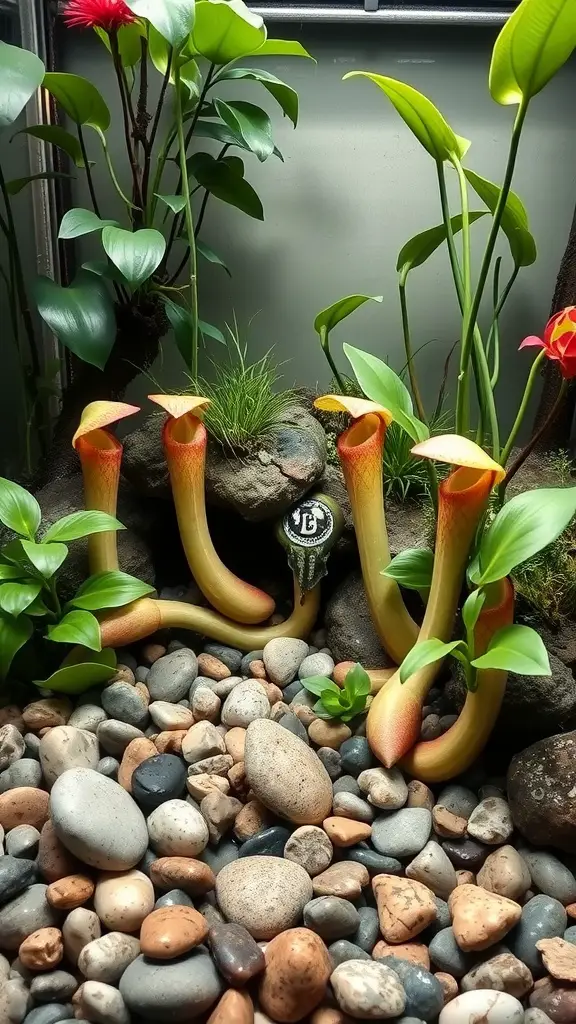
The Sarracenia swamp scene is a delightful showcase of carnivorous plants. The vibrant Sarracenia, also known as pitcher plants, stand tall with their unique tubular shapes. Their bright colors, ranging from soft yellows to fiery reds, create a striking contrast against the lush greenery surrounding them.
In this terrarium, the rocks and pebbles add a natural touch, mimicking a swampy environment. The varied textures of the stones complement the smooth surfaces of the plants. This setup not only looks great but also provides a suitable habitat for the Sarracenia.
Adding small decorative elements, like the little clock peeking from behind the plants, gives it a personal touch. It’s a reminder that these plants thrive in their own unique ecosystem, capturing insects for nourishment while adding beauty to your space.
Seasonal Carnivorous Display
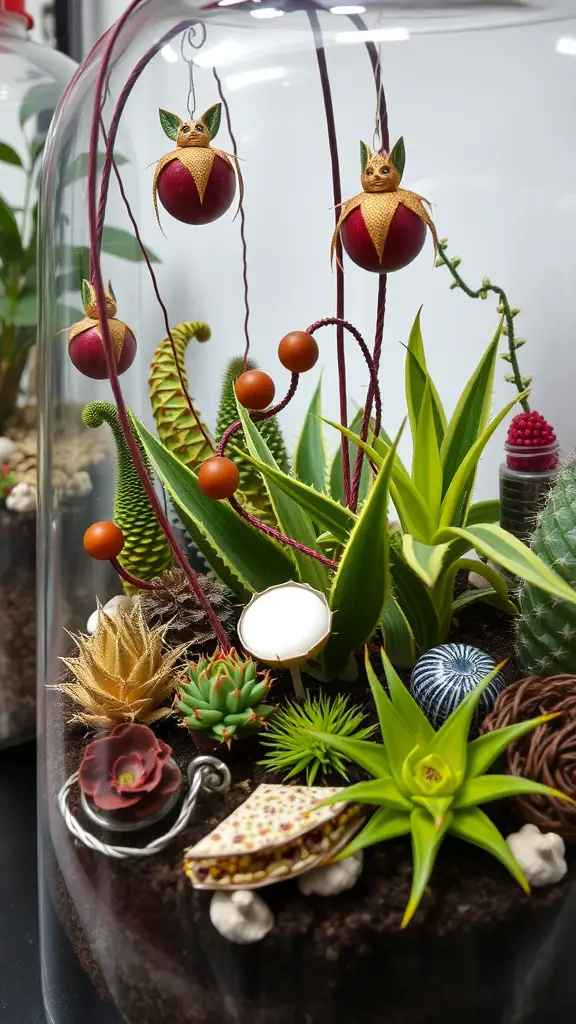
Creating a seasonal carnivorous plant terrarium can be a fun and creative way to showcase these unique plants. The image features a beautifully arranged terrarium filled with various carnivorous plants, each adding its own charm. The vibrant colors and textures make it visually appealing, perfect for any season.
In this display, you can see a mix of plants, including some that resemble small sculptures. The playful decorations, like the hanging ornaments, add a whimsical touch, making the terrarium not just a plant display but a piece of art. This is a great way to bring a bit of nature indoors while also celebrating the changing seasons.
Consider using seasonal themes for your terrarium. For instance, in autumn, you might add small pumpkins or colored leaves, while in spring, bright flowers can enhance the look. This approach keeps your display fresh and engaging throughout the year.
Creative Terrarium with Recycled Materials
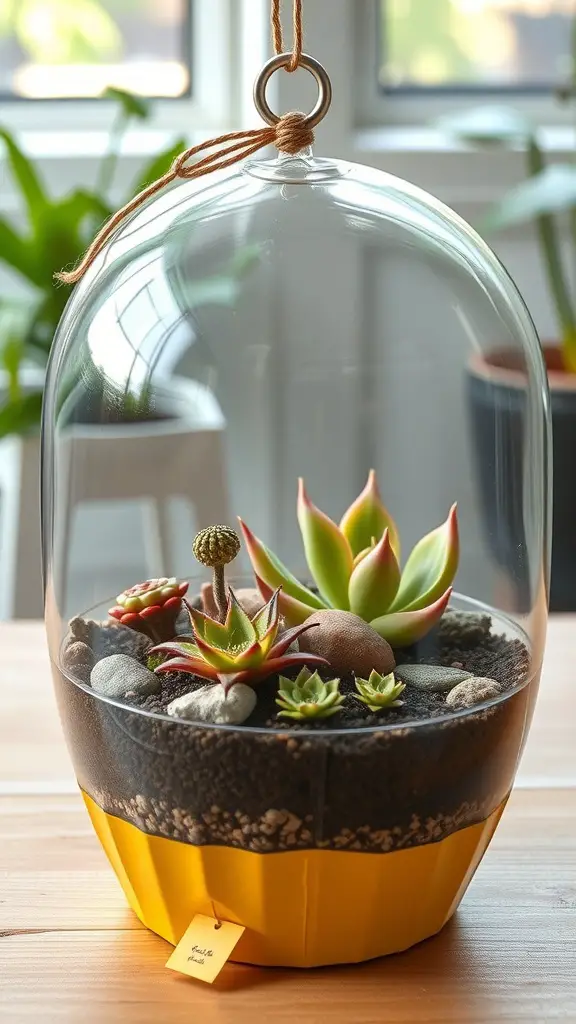
Creating a terrarium using recycled materials is a fun and eco-friendly project. The image shows a charming terrarium housed in a clear glass dome, which allows for a beautiful view of the plants inside. The base is a vibrant yellow, adding a pop of color to the overall design.
This terrarium features a variety of succulent plants, each with unique shapes and colors. The use of small rocks and soil creates a natural look, making it a perfect centerpiece for any room. The clear glass not only protects the plants but also lets in light, helping them thrive.
Using recycled materials can make your terrarium even more special. Consider using old jars, bottles, or even tin cans as containers. This not only saves money but also reduces waste. You can personalize your terrarium by adding decorative stones or figurines that reflect your style.
Overall, this creative approach to terrariums showcases how easy it is to blend nature with sustainability. It’s a delightful way to bring a bit of greenery into your space while being kind to the planet.
Aquatic Carnivore Delight

Imagine a vibrant terrarium filled with unique carnivorous plants. This setup showcases a stunning blend of colors and textures. The tall, elegant flowers reach for the light, while the smaller, round plants create a striking contrast below.
The bright yellow flowers stand out, drawing attention with their intricate shapes. They are not just pretty; these plants are designed to catch insects, making them fascinating additions to any collection. The lush green foliage adds a refreshing touch, creating a mini ecosystem that thrives in its glass home.
Using a clear container allows you to appreciate the beauty of these plants from every angle. The dark stones and soil provide a natural base, enhancing the overall look. This terrarium is not just a display; it’s a lively habitat that can spark curiosity and admiration.
Stylish Glass Terrarium
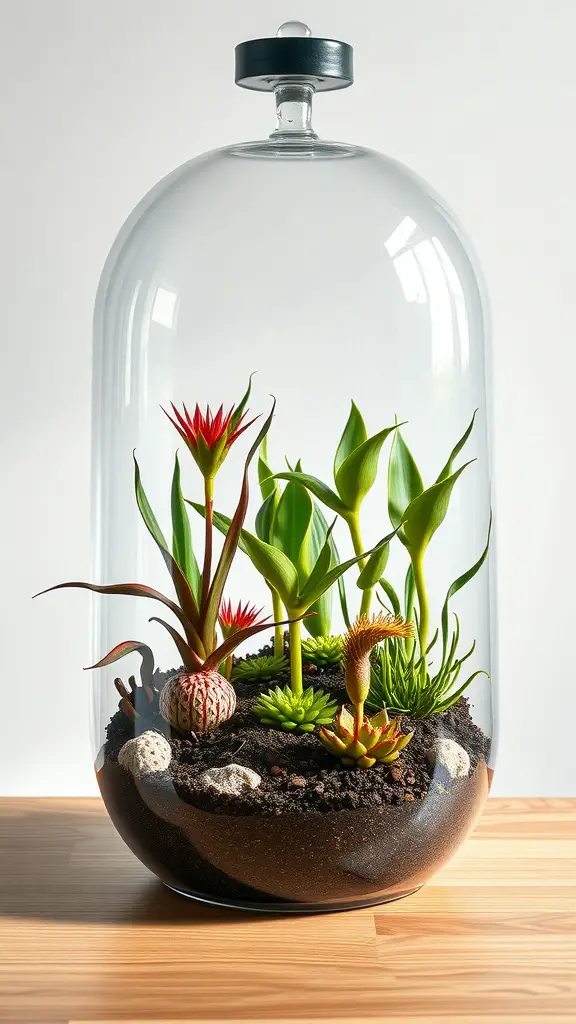
A stylish glass terrarium can be a stunning addition to any space. This particular terrarium showcases a variety of carnivorous plants, each with unique shapes and colors. The clear glass dome allows for a full view of the plants, creating a mini ecosystem that captures attention.
The vibrant red and green hues of the plants contrast beautifully against the dark soil. The arrangement is thoughtfully designed, with taller plants in the back and shorter ones in front, making it visually appealing from all angles. Small decorative stones add an extra touch, enhancing the overall aesthetic.
Maintaining a glass terrarium is relatively easy. It requires minimal watering and provides a great way to learn about plant care. Plus, it’s a fun project for anyone interested in gardening or home decor. A stylish glass terrarium not only serves as a decorative piece but also brings a bit of nature indoors.
Vintage Terrarium Aesthetic
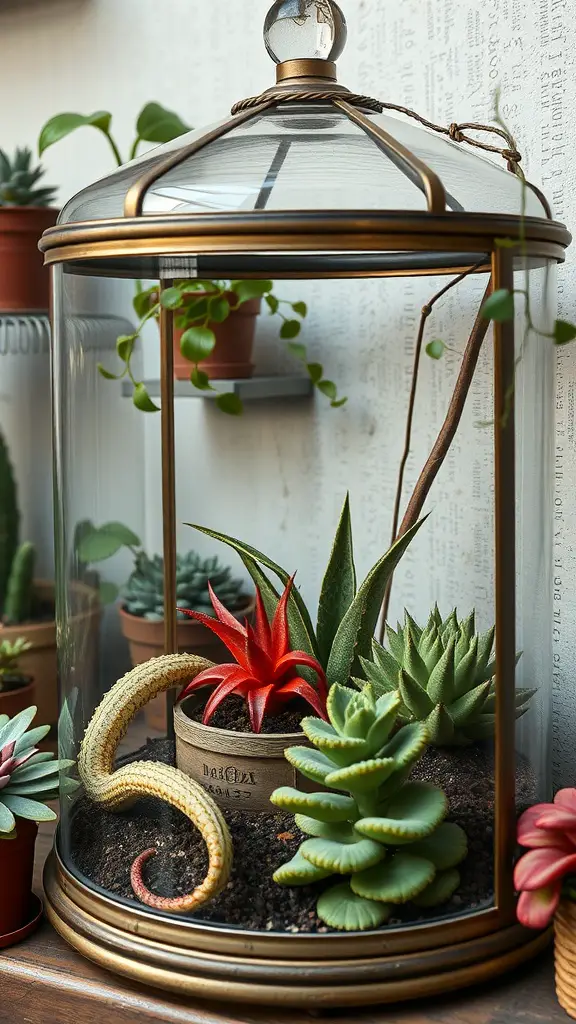
The vintage terrarium aesthetic brings a unique charm to any space. Imagine a glass enclosure filled with vibrant carnivorous plants, each one adding its own flair. The terrarium in the image showcases a beautiful blend of colors and textures, creating a miniature garden that feels both nostalgic and fresh.
The use of a classic glass dome with a brass finish enhances the vintage vibe. Inside, the striking red plant stands out against the lush greens, while the earthy tones of the soil ground the entire scene. This mix not only draws the eye but also invites curiosity about the plants themselves.
Adding elements like small decorative stones or vintage figurines can elevate the aesthetic even more. The terrarium becomes a conversation starter, a piece of art that reflects personal style. Whether you place it on a shelf or a coffee table, it adds a touch of nature and elegance to your home.
Desert-Inspired Carnivorous Plants
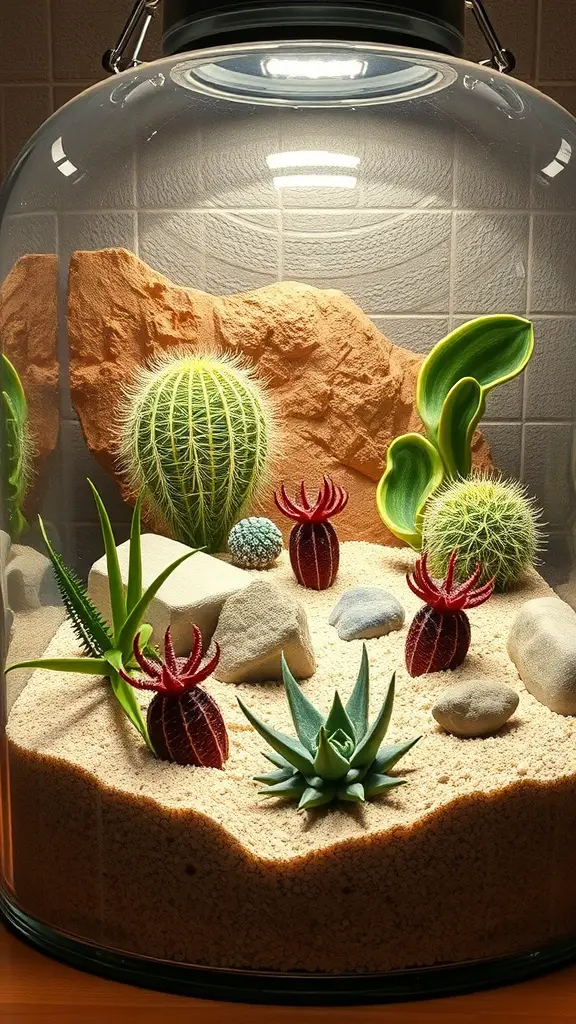
Creating a desert-inspired terrarium can be a fun and unique way to showcase carnivorous plants. The image captures a beautiful arrangement of these fascinating plants, set against a backdrop of sandy soil and rocks. The vibrant colors of the plants stand out against the neutral tones of the sand and stones, creating an eye-catching display.
In this setup, you can see various carnivorous species that thrive in arid conditions. The red and green hues of the plants add a pop of color, while the sandy substrate mimics their natural habitat. This combination not only looks great but also provides a suitable environment for these plants to flourish.
When planning your own desert-themed terrarium, consider using plants like the Venus flytrap or sundew. These species are not only visually appealing but also relatively easy to care for. Pair them with decorative stones and a few succulents to enhance the desert vibe.
Carnivorous Plant Fairy Garden
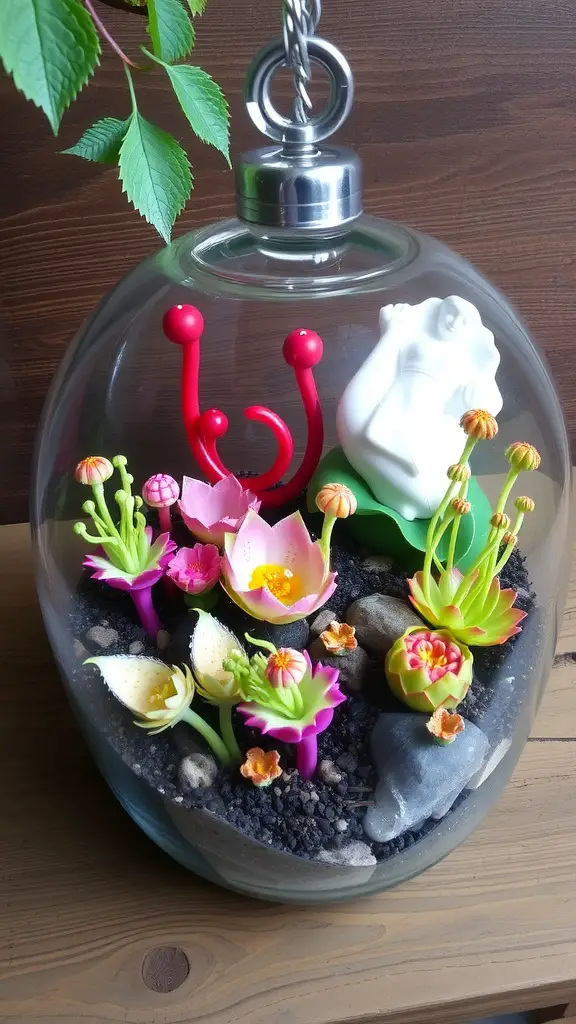
Carnivorous plant terrariums can be a delightful addition to any home, especially when styled as a fairy garden. Imagine a tiny world where vibrant plants and whimsical decorations come together. In this setup, you see a charming little house surrounded by various carnivorous plants, creating a magical atmosphere.
The bright green plants, like the Venus flytrap, stand out beautifully against the earthy tones of the soil. They not only look stunning but also serve a purpose by attracting insects. The playful decorations, such as the miniature fairy and colorful flowers, add a fun touch to the scene.
Each element in this fairy garden contributes to a story. The small house invites you to imagine fairies living among the plants, tending to them and enjoying their company. This setup is not just about aesthetics; it’s a way to connect with nature and spark creativity.
Creating your own carnivorous plant fairy garden can be a rewarding project. Start with a glass container, add soil, and choose your favorite carnivorous plants. Then, sprinkle in some decorative elements like stones, tiny figures, or even miniature furniture. The possibilities are endless!


